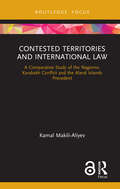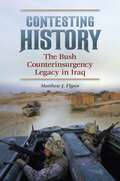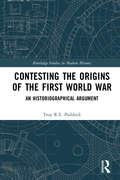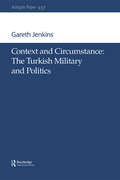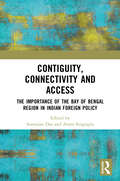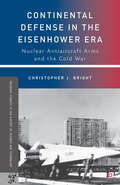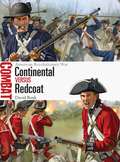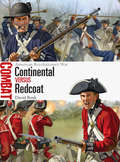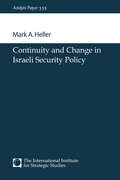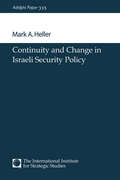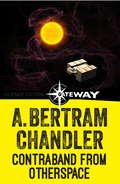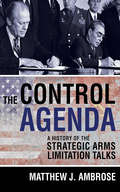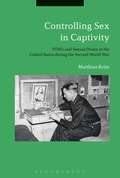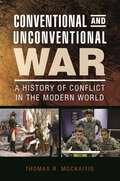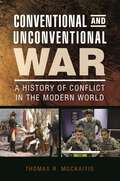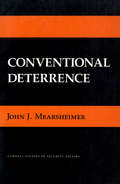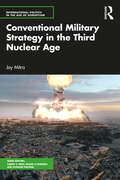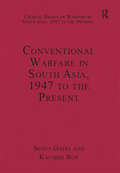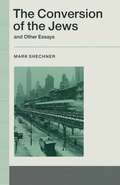- Table View
- List View
Contested Territories and International Law: A Comparative Study of the Nagorno-Karabakh Conflict and the Aland Islands Precedent
by Kamal Makili-AliyevThis book considers the possibilities for resolution of the Nagorno-Karabakh Conflict in the context of comparative international law. The armed conflict between Armenia and Azerbaijan over the territory of the Nagorno-Karabakh has been on the peace and security agenda since the dissolution of the Soviet Union. This volume draws parallels with a similar situation between Sweden and Finland over sovereignty of the Aland Islands in the early 20th century. Resolved in 1921, it is argued that this represents a model autonomy solution for territorial conflicts that include questions of territorial integrity, self-determination and minority rights. The book compares both conflict situations from the international law perspective, finding both commonalities and dissimilarities. It advances the application of the solution found in the Aland Islands precedent as a model for the resolution of the Nagorno-Karabakh Conflict, and provides appropriate recommendations for its implementation. The book will be of interest to academics, researchers and policymakers in the areas of international law and security, conflict resolution and international relations.
Contesting History: The Bush Counterinsurgency Legacy in Iraq (Praeger Security International)
by Matthew FlynnIn this book, the Bush administration's war in Iraq is assessed using an interdisciplinary approach and historical analysis that will help readers better understand the results of the U.S. counterinsurgency doctrine from 2003 to the present.Contesting History: The Bush Counterinsurgency Legacy in Iraq uses a comparative analysis of history to assess the Bush administration's actions in Iraq, focusing specifically on the policy of counterinsurgency. Insurgency exists within an extended timeframe and exhibits a global reach, argues comparative warfare expert Matthew J. Flynn. Therefore, understanding this phenomenon is best realized through an examination of guerrilla conflicts around the world over time; this book provides that approach. The work analyzes U.S. counterinsurgency doctrine during the Iraq War from 2003 to the present, and offers relevant historical comparisons to conflicts dating back to the mid-19th century, in which a nation enjoyed marked military superiority over their enemy. In doing so, it encourages readers to link the Afghanistan and Iraq wars in the broad context of the utilization of counterinsurgency operations to achieve policy objectives. Ultimately, the book illustrates how the tactical "military" success of the U.S. surge in Iraq still nets a strategic failure.
Contesting the Origins of the First World War: An Historiographical Argument (Routledge Studies in Modern History)
by Troy R PaddockContesting the Origins of the First World War challenges the Anglophone emphasis on Germany as bearing the primary responsibility in causing the conflict and instead builds upon new perspectives to reconsider the roles of the other Great Powers. Using the work of Terrance Zuber, Sean McMeekin, and Stefan Schmidt as building blocks, this book reassesses the origins of the First World War and offers an explanation as to why this reassessment did not come about earlier. Troy R.E. Paddock argues that historians need to redraw the historiographical map that has charted the origins of the war. His analysis creates a more balanced view of German actions by also noting the actions and inaction of other nations. Recent works about the roles of the five Great Powers involved in the events leading up to the war are considered, and Paddock concludes that Germany does not bear the primary responsibility. This book provides a unique historiographical analysis of key texts published on the origins of the First World War, and its narrative encourages students to engage with and challenge historical perspectives.
Contesting the Origins of the First World War: An Historiographical Argument (Routledge Studies in Modern History)
by Troy R PaddockContesting the Origins of the First World War challenges the Anglophone emphasis on Germany as bearing the primary responsibility in causing the conflict and instead builds upon new perspectives to reconsider the roles of the other Great Powers. Using the work of Terrance Zuber, Sean McMeekin, and Stefan Schmidt as building blocks, this book reassesses the origins of the First World War and offers an explanation as to why this reassessment did not come about earlier. Troy R.E. Paddock argues that historians need to redraw the historiographical map that has charted the origins of the war. His analysis creates a more balanced view of German actions by also noting the actions and inaction of other nations. Recent works about the roles of the five Great Powers involved in the events leading up to the war are considered, and Paddock concludes that Germany does not bear the primary responsibility. This book provides a unique historiographical analysis of key texts published on the origins of the First World War, and its narrative encourages students to engage with and challenge historical perspectives.
Context and Circumstance: The Turkish Military and Politics (Adelphi series #337)
by Gareth JenkinsDebates about military influence on civilian government tend to be partisan and rarely pay sufficient attention to specific contexts. This paper analyses, without condemnation or justification, why and how the military exercises such influence in Turkey and whether it is likely to continue to do so. It argues that the role of the military in Turkey grows out of a specific Turkish context and is more a symptom than a cause of the country's flawed democracy. It examines the Turkish officer ethos, particularly the role of the indigenous ideology of Kemalism, and the broad, though not universal, public mandate for an interventionist role in politics. It contends that the military's influence is neither uniform nor total and that it is more effective at blocking than initiating policy; thus creating a system in which civilian authority is primary rather than supreme. It analyses the mechanisms through which the military attempts to shape policy, and demonstrates how its influence depends more on its informal authority than legislated rights or responsibilities. The paper suggests that fears of threats to national security resulting from the reforms required for EU accession have made the military more, not less, reluctant to withdraw from the political arena. It concludes that, regardless of the future of Turkey's candidacy, such a withdrawal will be a slow and gradual process, dependent more on changes in Turkish social and political culture and the perceived security environment than in the military itself.
Context and Circumstance: The Turkish Military and Politics (Adelphi series)
by Gareth JenkinsDebates about military influence on civilian government tend to be partisan and rarely pay sufficient attention to specific contexts. This paper analyses, without condemnation or justification, why and how the military exercises such influence in Turkey and whether it is likely to continue to do so. It argues that the role of the military in Turkey grows out of a specific Turkish context and is more a symptom than a cause of the country's flawed democracy. It examines the Turkish officer ethos, particularly the role of the indigenous ideology of Kemalism, and the broad, though not universal, public mandate for an interventionist role in politics. It contends that the military's influence is neither uniform nor total and that it is more effective at blocking than initiating policy; thus creating a system in which civilian authority is primary rather than supreme. It analyses the mechanisms through which the military attempts to shape policy, and demonstrates how its influence depends more on its informal authority than legislated rights or responsibilities. The paper suggests that fears of threats to national security resulting from the reforms required for EU accession have made the military more, not less, reluctant to withdraw from the political arena. It concludes that, regardless of the future of Turkey's candidacy, such a withdrawal will be a slow and gradual process, dependent more on changes in Turkish social and political culture and the perceived security environment than in the military itself.
Contiguity, Connectivity and Access: The Importance of the Bay of Bengal Region in Indian Foreign Policy
by Suranjan Das Anita SenguptaThis volume examines themes like contemporary factors shaping the emergence of the Bay of Bengal region as a critical strategic theatre in Indian foreign policy; the inter-connectedness of the Indian and Pacific Oceans; the importance of oceans to security and commerce and India’s role within the broader region; the twenty-first century maritime Silk Road and Indian alternatives and the possibilities of reconnecting disconnected spaces through re-imagining a Bay of Bengal Community. In this connection the volume takes particular note of the emerging regional cooperative order for the promotion of peace and development in the Bay of Bengal region (BIMSTEC). The volume brings together historians, political analysts and political economists to emphasize the interconnectedness of the oceanic space through a detailed analysis of the Bay of Bengal as a space of strategic and economic significance, particularly for India, but also as a space for re-imagining a new regional community. Print edition not for sale in South Asia (India, Sri Lanka, Nepal, Bangladesh, Pakistan and Bhutan).
Contiguity, Connectivity and Access: The Importance of the Bay of Bengal Region in Indian Foreign Policy
by Suranjan Das Anita SenguptaThis volume examines themes like contemporary factors shaping the emergence of the Bay of Bengal region as a critical strategic theatre in Indian foreign policy; the inter-connectedness of the Indian and Pacific Oceans; the importance of oceans to security and commerce and India’s role within the broader region; the twenty-first century maritime Silk Road and Indian alternatives and the possibilities of reconnecting disconnected spaces through re-imagining a Bay of Bengal Community. In this connection the volume takes particular note of the emerging regional cooperative order for the promotion of peace and development in the Bay of Bengal region (BIMSTEC). The volume brings together historians, political analysts and political economists to emphasize the interconnectedness of the oceanic space through a detailed analysis of the Bay of Bengal as a space of strategic and economic significance, particularly for India, but also as a space for re-imagining a new regional community. Print edition not for sale in South Asia (India, Sri Lanka, Nepal, Bangladesh, Pakistan and Bhutan).
Continental Defense in the Eisenhower Era: Nuclear Antiaircraft Arms and the Cold War (Palgrave Studies in the History of Science and Technology)
by C. BrightThousands of nuclear antiaircraft arms were designed, tested and deployed in the United States during Dwight D. Eisenhower's presidency. These Army "Nike-Hercules" missiles, Air Force "Genie" rockets, and "BOMARC" and "Falcon" missiles were meant to counter a raid by attacking Soviet bombers. U.S. policy makers believed that the American weapons could safely compensate for technological limitations which otherwise made it difficult to destroy high flying, fast moving airplanes. Continental Defense in the Eisenhower Era traces this armament from conception through deployment. Bright recounts official actions, doctrinal decisions, and public policies. It also discusses the widespread acceptance of these weapons by the American public, a result of being touted in news releases, featured in films and television episodes, and disseminated throughout society as a whole.
Continental vs Redcoat: American Revolutionary War (Combat #9)
by Johnny Shumate David BonkThe American Revolutionary War pitched the newly formed Continental Army against the professional British Redcoats – a highly trained organization manned by long-serving and experienced infantrymen with a formidable reputation forged on European battlefields during the Seven Years' War. So, how were the poorly trained, poorly supplied Continental infantry able to hold their own and shape the outcome of the Revolutionary War and establish the future of their young nation? David Bonk answers this question in a highly illustrated book that looks at the challenges facing both armies, weighing up how each side was able to cope with the day-to-day experiences of the war and using extensive first-hand accounts to allow a modern audience to experience what life was like for soldiers on and off the battlefield during the war.
Continental vs Redcoat: American Revolutionary War (Combat #9)
by Johnny Shumate David BonkThe American Revolutionary War pitched the newly formed Continental Army against the professional British Redcoats – a highly trained organization manned by long-serving and experienced infantrymen with a formidable reputation forged on European battlefields during the Seven Years' War. So, how were the poorly trained, poorly supplied Continental infantry able to hold their own and shape the outcome of the Revolutionary War and establish the future of their young nation? David Bonk answers this question in a highly illustrated book that looks at the challenges facing both armies, weighing up how each side was able to cope with the day-to-day experiences of the war and using extensive first-hand accounts to allow a modern audience to experience what life was like for soldiers on and off the battlefield during the war.
Continuity and Change in Israeli Security Policy (Adelphi series #No.335)
by Mark A. HellerHow should Israel respond to the changing external threats that confront it? This paper argues that the country's traditional security concept is obsolete and must be reformulated. How this is achieved depends on developments within the Middle East and on the outcome of current shifts in Israel's politics and society.
Continuity and Change in Israeli Security Policy (Adelphi series)
by Mark A. HellerHow should Israel respond to the changing external threats that confront it? This paper argues that the country's traditional security concept is obsolete and must be reformulated. How this is achieved depends on developments within the Middle East and on the outcome of current shifts in Israel's politics and society.
Contraband from Otherspace (John Grimes)
by A. Bertram ChandlerA deadly cargo that threatens to sheer through the fabric of reality, like a knife through soft butter.
The Control Agenda: A History of the Strategic Arms Limitation Talks
by Matthew J. AmbroseThe Control Agenda is a sweeping account of the history of the Strategic Arms Limitation Talks (SALT), their rise in the Nixon and Ford administrations, their downfall under President Carter, and their powerful legacies in the Reagan years and beyond.Matthew Ambrose pays close attention to the interplay of diplomacy, domestic politics, and technology, and finds that the SALT process was a key point of reference for arguments regarding all forms of Cold War decision making. Ambrose argues elite U.S. decision makers used SALT to better manage their restive domestic populations and to exert greater control over the shape, structure, and direction of their nuclear arsenals.Ambrose also asserts that prolonged engagement with arms control issues introduced dynamic effects into nuclear policy. Arms control considerations came to influence most areas of defense decision making, while the measure of stability SALT provided allowed the examination of new and potentially dangerous nuclear doctrines. The Control Agenda makes clear that verification and compliance concerns by the United States prompted continuous reassessments of Soviet capabilities and intentions; assessments that later undergirded key U.S. policy changes toward the Soviet Union. Through SALT’s many twists and turns, accusations and countercharges, secret backchannels and propaganda campaigns the specter of nuclear conflict loomed large.
Controlling Sex in Captivity: POWs and Sexual Desire in the United States during the Second World War
by Matthias ReissControlling Sex in Captivity is the first book to examine the nature, extent and impact of the sexual activities of Axis prisoners of war in the United States during the Second World War. Historians have so far interpreted the interactions between captors and captives in America as the beginning of the post-war friendship between the United States, Germany and Italy. Matthias Reiss argues that this paradigm is too simplistic. Widespread fraternisation also led to sexual relationships which created significant negative publicity, and some Axis POWs got caught up in the U.S. Army's new campaign against homosexuals.By focusing on the fight against fraternisation and same-sex activities, this study treads new ground. It stresses that contact between captors and captives was often loaded with conflict and influenced by perceptions of gender and race. It highlights the transnational impact of fraternisation and argues that the prisoners' sojourn in the United States also influenced American society by fuelling a growing concern about social disintegration and sexual deviancy, which eventually triggered a conservative backlash after the war.
Controlling Sex in Captivity: POWs and Sexual Desire in the United States during the Second World War
by Matthias ReissControlling Sex in Captivity is the first book to examine the nature, extent and impact of the sexual activities of Axis prisoners of war in the United States during the Second World War. Historians have so far interpreted the interactions between captors and captives in America as the beginning of the post-war friendship between the United States, Germany and Italy. Matthias Reiss argues that this paradigm is too simplistic. Widespread fraternisation also led to sexual relationships which created significant negative publicity, and some Axis POWs got caught up in the U.S. Army's new campaign against homosexuals.By focusing on the fight against fraternisation and same-sex activities, this study treads new ground. It stresses that contact between captors and captives was often loaded with conflict and influenced by perceptions of gender and race. It highlights the transnational impact of fraternisation and argues that the prisoners' sojourn in the United States also influenced American society by fuelling a growing concern about social disintegration and sexual deviancy, which eventually triggered a conservative backlash after the war.
Conventional and Unconventional War: A History of Conflict in the Modern World
by Thomas R. MockaitisThis volume offers a comprehensive history of warfare since 1648, covering conventional and unconventional operations and demonstrating how most modern wars have been hybrid affairs that involved both. The book uses a broad range of conflicts to explore the societal forces that have shaped wars.Written by noted military historian Thomas R. Mockaitis, this book explores conventional and unconventional conflicts and considers the relationships between them. It considers how epic struggles like the American Civil War, World Wars I and II, and the conflicts in the Middle East, among many others, shaped human history. The coverage serves to highlight four themes: the relationship between armed forces and the societies that create them; the impact of technology (not just armaments) on warfare; the role of ideas and attitudes towards violence in determining why and how wars are fought; and the relationship between conventional and unconventional operations.The book also covers the advent and evolution of unconventional warfare, including counterinsurgency, the War on Terror, and current conflicts in the Middle East. It concludes with consideration of the forms armed conflict will take in the future. The book includes valuable excerpts from the writings of military thinkers such as Clausewitz and Sun Tzu, an extensive bibliography of primary and secondary sources, and supporting maps and diagrams.
Conventional and Unconventional War: A History of Conflict in the Modern World
by Thomas R. MockaitisThis volume offers a comprehensive history of warfare since 1648, covering conventional and unconventional operations and demonstrating how most modern wars have been hybrid affairs that involved both. The book uses a broad range of conflicts to explore the societal forces that have shaped wars.Written by noted military historian Thomas R. Mockaitis, this book explores conventional and unconventional conflicts and considers the relationships between them. It considers how epic struggles like the American Civil War, World Wars I and II, and the conflicts in the Middle East, among many others, shaped human history. The coverage serves to highlight four themes: the relationship between armed forces and the societies that create them; the impact of technology (not just armaments) on warfare; the role of ideas and attitudes towards violence in determining why and how wars are fought; and the relationship between conventional and unconventional operations.The book also covers the advent and evolution of unconventional warfare, including counterinsurgency, the War on Terror, and current conflicts in the Middle East. It concludes with consideration of the forms armed conflict will take in the future. The book includes valuable excerpts from the writings of military thinkers such as Clausewitz and Sun Tzu, an extensive bibliography of primary and secondary sources, and supporting maps and diagrams.
Conventional Deterrence (Cornell Studies in Security Affairs)
by John J. MearsheimerConventional Deterrence is a book about the origins of war. Why do nations faced with the prospect of large-scale conventional war opt for or against an offensive strategy? John J. Mearsheimer examines a number of crises that led to major conventional wars to explain why deterrence failed. He focuses first on Allied and German decision making in the years 1939–1940, analyzing why the Allies did not strike first against Germany after declaring war and, conversely, why the Germans did attack the West. Turning to the Middle East, he examines the differences in Israeli and Egyptian strategic doctrines prior to the start of the major conventional conflicts in that region. Mearsheimer then critically assays the relative strengths and weaknesses of NATO and the Warsaw Pact to determine the prospects for conventional deterrence in any future crisis. He is also concerned with examining such relatively technical issues as the impact of precision-guided munitions (PGM) on conventional deterrence and the debate over maneuver versus attrition warfare.Mearsheimer pays considerable attention to questions of military strategy and tactics. Challenging the claim that conventional detrrence is largely a function of the numerical balance of forces, he also takes issue with the school of thought that ascribes deterrence failures to the dominance of "offensive" weaponry. In addition to examining the military consideration underlying deterrence, he also analyzes the interaction between those military factors and the broader political considerations that move a nation to war.
Conventional Military Strategy in the Third Nuclear Age (International Politics in the Age of Disruption)
by Joy MitraThis volume delves into the way conventional deterrence operates between nuclear-armed states in the third nuclear age. Unlike the first and second ages the advent of this new age has witnessed greater strain on the principles of mutual vulnerability and survivability that may result in increased risks of advertent or inadvertent escalation and horizontal nuclear proliferation. The book looks at the sum of three key simultaneous developments in the third nuclear age that merit attention. These include the emergence of asymmetric strategies, the introduction of unmanned platforms and the expansion of nuclear arsenals. The volume discusses how these concurrent developments might shape the practice of conventional deterrence and provides useful insights into conventional military dynamics, not just among the current nuclear dyads but also ones that may emerge in future. It seeks answers to several key issues in state security not limited to — • What purpose and scope does the conventional military instrument have in a state’s overall military strategy versus other nuclear-armed states? • If mutual vulnerability and deterrence are the frameworks, why did the prospect of escalation appear in the first place? • What are the trends — political, doctrinal, or technological — that augment or diminish conventional and nuclear interface? With insights on military crises that have witnessed participation from nuclear-armed states like the United States, Russia, China, Pakistan, and India this book will especially be of interest to scholars and researchers working in the areas of security and deterrence studies, defence and strategic studies, peace and conflict studies, and foreign policy. It will also appeal to policymakers, career bureaucrats, security and defense practitioners, and professionals working with think tanks and embassies.
Conventional Military Strategy in the Third Nuclear Age (International Politics in the Age of Disruption)
by Joy MitraThis volume delves into the way conventional deterrence operates between nuclear-armed states in the third nuclear age. Unlike the first and second ages the advent of this new age has witnessed greater strain on the principles of mutual vulnerability and survivability that may result in increased risks of advertent or inadvertent escalation and horizontal nuclear proliferation. The book looks at the sum of three key simultaneous developments in the third nuclear age that merit attention. These include the emergence of asymmetric strategies, the introduction of unmanned platforms and the expansion of nuclear arsenals. The volume discusses how these concurrent developments might shape the practice of conventional deterrence and provides useful insights into conventional military dynamics, not just among the current nuclear dyads but also ones that may emerge in future. It seeks answers to several key issues in state security not limited to — • What purpose and scope does the conventional military instrument have in a state’s overall military strategy versus other nuclear-armed states? • If mutual vulnerability and deterrence are the frameworks, why did the prospect of escalation appear in the first place? • What are the trends — political, doctrinal, or technological — that augment or diminish conventional and nuclear interface? With insights on military crises that have witnessed participation from nuclear-armed states like the United States, Russia, China, Pakistan, and India this book will especially be of interest to scholars and researchers working in the areas of security and deterrence studies, defence and strategic studies, peace and conflict studies, and foreign policy. It will also appeal to policymakers, career bureaucrats, security and defense practitioners, and professionals working with think tanks and embassies.
Conventional Warfare in South Asia, 1947 to the Present (Critical Essays on Warfare in South Asia, 1947 to the Present)
by Kaushik RoyThe essays included in this volume focus on conventional war on land, sea and air fought by the states of South Asia and their impact on the host societies and economies. The authors are drawn from academia and the military in India and Pakistan, as well as from outside the subcontinent in order to give a wide perspective. In the introduction the editors describe the changing contours of warfare in South Asia, and the similarities and dissimilarities with warfare in the Middle East and South East Asia. The volume highlights the influence of extra-regional powers like China, Russia and the US in providing arms, munitions and shaping the texture of military doctrines and force structures of the South Asian powers.
Conventional Warfare in South Asia, 1947 to the Present (Critical Essays on Warfare in South Asia, 1947 to the Present)
by Kaushik RoyThe essays included in this volume focus on conventional war on land, sea and air fought by the states of South Asia and their impact on the host societies and economies. The authors are drawn from academia and the military in India and Pakistan, as well as from outside the subcontinent in order to give a wide perspective. In the introduction the editors describe the changing contours of warfare in South Asia, and the similarities and dissimilarities with warfare in the Middle East and South East Asia. The volume highlights the influence of extra-regional powers like China, Russia and the US in providing arms, munitions and shaping the texture of military doctrines and force structures of the South Asian powers.
